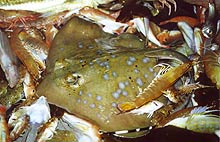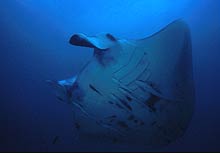Rays are a common catch within many fisheries, both inshore and offshore. Although rays are targeted in fisheries elsewhere in the world, in Australia they are largely caught accidentally, as a bycatch of commercial and recreational fisheries targeting other species. Most fishing pressure occurs in waters over the continental shelves, putting the species living in this area at risk. Deep-sea rays are even more at risk to fishing pressures than coastal and pelagic species, as the low productivity of the deep-sea floor means that many of the species found there grow extremely slowly and have a low reproductive rate.
As a consequence, many of these species are naturally rare. Many species are found in only a small area, while others may live only in specific habitats over a wider area. Fisheries in the deep-sea are still being commercially developed, and rays will increasingly be caught as bycatch in these areas. Unfortunately, the low reproductive rate of these rays means that species can be heavily reduced, even to extinction, before the targeted bony fish species shows a significant decline in catch.
Habitat modification and pollution are also major issues for some inshore species. Estuarine and coastal areas are suffering increasing alteration through development, restriction of river flows, land reclamation and other pressures. The young of many inshore species spend their first few months or years in high productivity ‘nursery’ areas. Often these nursery areas are located in estuaries or shallow mangrove-fringed ecosystems where there is plenty of food and protection from larger predators. The destruction of these nursery areas can result in a permanent reduction in the local ray population.
Conclusion
Rays are present in most marine ecosystems worldwide, and have a vital role in maintaining the health and function of these ecosystems. Their ecological niche has been little-studied when compared to sharks, but their diversity, abundance and worldwide distribution are evidence of their success. The challenge for marine science now is to ensure these rays are protected, so they do not quietly disappear before we can fully understand just how important they are.
Harry Breidahl adapted this information sheet for children (which is suitable for primary school students) from the information sheet compiled for the general public by © Simon Pierce (simon.pierce@uq.edu.au).
This information sheet may be copied for educational purposes. For any other purpose please contact your State MESA representative: http://www.mesa.edu.au/council/contacts.asp
|

This bluespot maskray (D asyatis kuhlii )
seen on the sorting tray of a trawler
was caught as bycatch in a prawn fishery.
(© Peter Kyne)

Manta rays can grow to have a wingspan
many metres across, but feed on small
organisms filtered from the water. They
are often accompanied by remoras
or
suckerfish that ‘hitch a ride’ to the rays
using a specialised suction mechanism
on the top of their head.
(© Andrea Marshall)
|
